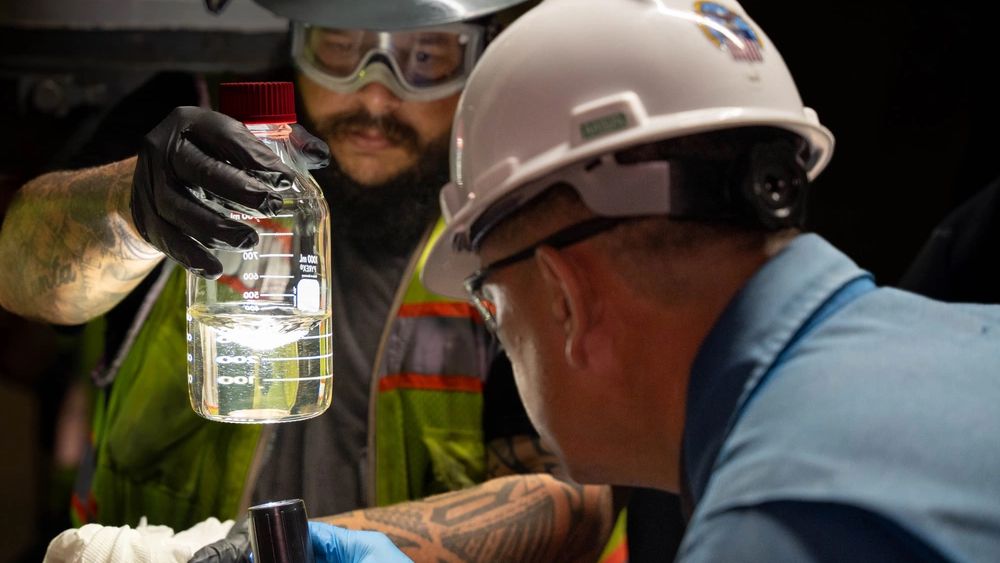PEARL HARBOR, Hawaii — On Friday, the Hawaii Department of Health released its health report regarding the Red Hill fuel leaks in 2021, according to a news release. The report said along with jet fuel, the Navy’s water system may have been contaminated with an icing inhibitor, Simple Green and chlorine.
According to DOH, the health report fills a gap in knowledge by providing information about what contaminants may have been in the Navy’s water following the Nov. 20, 2021, jet fuel spill at the Red Hill storage facility.
The report said the information should help assess people with ongoing health effects. Health effects associated with different levels of exposure to jet fuel and fuel additives are charted in the report.
As early as Nov. 25, 2021, residents at Joint Base Pearl Harbor-Hickam and the surrounding area reported smelling fuel and seeing sheens, foam and emulsions coming from the tap water. People experienced symptoms ranging from rashes, headaches, vertigo, coughs, diarrhea, nausea, vomiting, bleeding, convulsions and partial paralysis. On Nov. 28, 2021, the Red Hill Shaft, one of two wells serving the JBPHH, was shut down and is still closed.
The Navy collected samples from the contaminated drinking water system and tested for Total Organic Carbons, which are faster to process than the more comprehensive Total Petroleum Hydrocarbon and volatile organic compound data, according to the report.
On Nov. 29, 2021, the DOH issued an advisory urging JBPHH residents against using the tap water, but the Navy told people living in areas where the TOC was not elevated that they could use the water until Dec. 9, 2021. These people were sickened. Later, sampling results were determined to be unreliable. Many more people became sick in the following weeks as contaminated water circulated through the water system to other parts of the base.
According to the report, exposure to high concentrations of hydrocarbons causes eye and skin irritation, dermatitis, defatting of skin, dizziness, headache, anesthesia, coughing, gagging, vomiting, griping, diarrhea, depressed respiration and pulmonary edema.
Along with jet fuel, the water may have been contaminated with other additives, including an icing inhibitor known as diethylene glycol monomethyl ether (DiEGME). The report said, “DiEGME is of particular concern for potential health risks both because of its relatively higher concentration in the fuel in comparison to other additives and its predicted miscibility in water.” Health effects of acute exposure to DiEGME include headache, dizziness, tiredness, nausea, vomiting and eye irritation. Long term-exposure may include impacts on the alimentary tract, kidneys, skin, and on the developmental and reproductive systems.
The water may have also been contaminated by chlorine, which can cause eye and nose irritation as well as stomach discomfort, according to the report. “Residents reported periodic strong chlorine odors emitted from tap water in the weeks following release. This was apparently related to intentional, increased chlorination of the water by the Navy to address concerns about potential buildup of bacteria in the system,” the report said.
The Navy also used Simple Green All-Purpose Cleaner to clean the floors and walls at the Red Hill facility following the Nov. 2021 spill. The use of Simple Green may explain why residents who used the Navy’s water system reported seeing foam-like residue in the tap water.
Along with exposure to contaminated water, residents in the Red Hill and Aliamanu Military Reservation areas may have been exposed to fuel vapors in the air. The fuel vapors would have been in the highest concentrations in the weeks following the fuel release, according to the report. Residents in the JBPHH area may have also been exposed to fuel vapors when they were asked by the Navy to flush the tap water in their homes. After the home flushing, people reported headaches, vomiting and other acute health effects. For months after the leak, fuel vapors were also emitted during heavy rainfalls from soil that was contaminated when untreated water was discharged.
The report estimated people were exposed to contaminants for a few minutes to as long as two weeks before experiencing symptoms, depending on the concentration of the contaminants.
The report also said people may have also been exposed for a longer time to lower concentrations of contaminants following the May 6, 2021, release of jet fuel from the Red Hill facility. However, the Navy did not conduct a detailed analysis of what the contaminants may have been. The contaminants could have been from cleaning agents, petroleum, or algae.
Michelle Broder Van Dyke covers the Hawaiian Islands for Spectrum News Hawaii. Email her at michelle.brodervandyke@charter.com.






